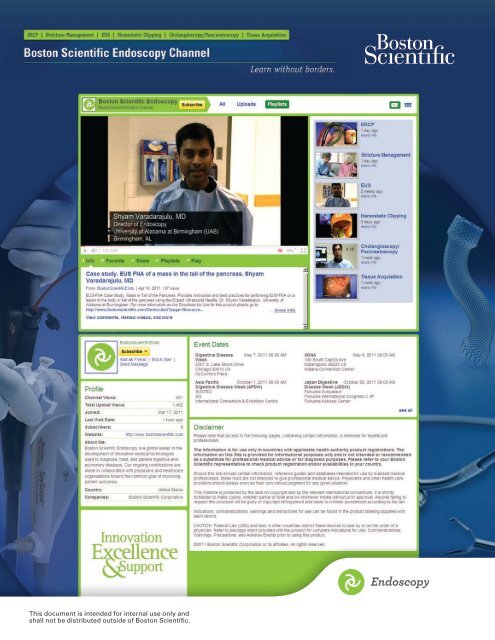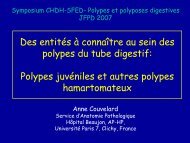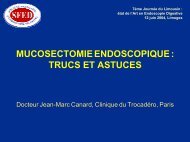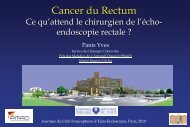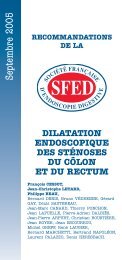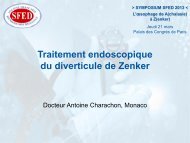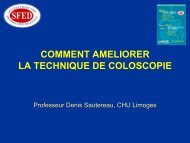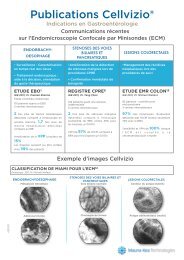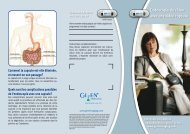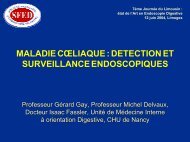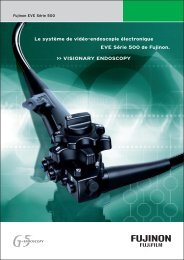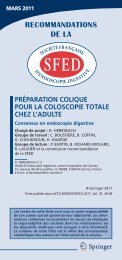This document is intended for internal use only and shall not ... - SFED
This document is intended for internal use only and shall not ... - SFED
This document is intended for internal use only and shall not ... - SFED
Create successful ePaper yourself
Turn your PDF publications into a flip-book with our unique Google optimized e-Paper software.
<strong>Th<strong>is</strong></strong> <strong>document</strong> <strong>is</strong> <strong>intended</strong> <strong>for</strong> <strong>internal</strong> <strong>use</strong> <strong>only</strong> <strong>and</strong><br />
<strong>shall</strong> <strong>not</strong> be d<strong>is</strong>tributed outside of Boston Scientific.
ERCP<br />
Playl<strong>is</strong>t<br />
Order<br />
1<br />
2<br />
3<br />
4<br />
5<br />
6<br />
7<br />
8<br />
Title<br />
Animation: Advanix Biliary<br />
Stent with NaviFlex RX<br />
Delivery System<br />
Animation: Biliary access<br />
cannulation techniques<br />
Perspectives on<br />
wire-guided cannulation,<br />
Prof. Marco Bruno<br />
Case Study Deployment of<br />
bi-lateral WallFlex ® Biliary RX<br />
Stents, Thomas Kowalski, MD<br />
Animation. WallFlex®<br />
Fully Covered Biliary<br />
Metal Stent animation<br />
with clinical footage<br />
Case Study. Deployment<br />
of a WallFlex ® Duodenal<br />
Stent, presented by<br />
Dr. Irving Waxman<br />
Q&A with MDs. When to Stent<br />
vs Surgery, Irving Waxman,<br />
MD (GI) & Kevin Roggin, MD<br />
(Surgeon)<br />
Q&A with MDs. Patient<br />
Selection <strong>for</strong> Duodenal<br />
Stents, Irving Waxman, MD<br />
& Kevin Roggin, MD<br />
Description<br />
Animation. Advanix Biliary Stent with NaviFlex RX<br />
Delivery System. <strong>Th<strong>is</strong></strong> animation demonstrates the<br />
general deployment procedure <strong>for</strong> the Advanix biliary<br />
stent system.<br />
<strong>Th<strong>is</strong></strong> animation demonstrates various biliary access<br />
cannulation techniques <strong>and</strong> the clinical benefits<br />
of each. Techniques include wire guided cannulation,<br />
catheter access <strong>and</strong> catheter engagement<br />
cannulation techniques.<br />
Physician perspective on short wire systems <strong>and</strong> wire<br />
guided cannulation: techniques, benefits, tips <strong>and</strong><br />
tricks. Prof. Marco Bruno.<br />
In-Depth Case Study. Deployment of bi-lateral<br />
WallFlex ® Biliary Metal Stents, presented by<br />
Dr. Thomas Kowalski of Thomas Jefferson University<br />
Hospital, Philadelphia, PA - takes you step by step<br />
through the deployment procedure <strong>for</strong> placing bi-lateral<br />
WallFlex Stents <strong>for</strong> biliary decompression.<br />
WallFlex ® Fully Covered Biliary Metal Stent animation.<br />
<strong>Th<strong>is</strong></strong> animation includes clinical footage <strong>and</strong><br />
demonstrates the features of th<strong>is</strong> stent as well<br />
as the deployment procedure. Footage courtesy<br />
of Dr. Thomas Kowalski.<br />
Case study. Deployment of a WallFlex ® Duodenal<br />
Stent, presented by Dr. Irving Waxman, University<br />
of Chicago, Pritzker School of Medicine, Chicago, IL.<br />
Q&A with physicians. When to Stent vs Surgery - with<br />
Dr. Irving Waxman (GI) <strong>and</strong> Dr. Kevin Roggin (Surgeon),<br />
University of Chicago, Pritzker School of Medicine,<br />
Chicago, IL.<br />
Q&A with physicians. Patient Selection <strong>for</strong> Duodenal<br />
Stents, with Dr.Irving Waxman (GI) <strong>and</strong> Dr. Kevin<br />
Roggin (Surgeon), University of Chicago, Pritzker<br />
School of Medicine, Chicago, IL.<br />
<strong>Th<strong>is</strong></strong> <strong>document</strong> <strong>is</strong> <strong>intended</strong> <strong>for</strong> <strong>internal</strong> <strong>use</strong> <strong>only</strong> <strong>and</strong> <strong>shall</strong> <strong>not</strong> be d<strong>is</strong>tributed outside of Boston Scientific.
9<br />
10<br />
11<br />
12<br />
13<br />
14<br />
15<br />
16<br />
Case study. Large stone<br />
therapy using Holmium Laser<br />
with SpyGlass ® System,<br />
S<strong>and</strong>eep Patel, DO<br />
Case Study. Large stone<br />
therapy using EHL with<br />
SpyGlass ® System, D.<br />
Pleskow, MD<br />
Case Study. T<strong>is</strong>sue Acqu<strong>is</strong>ition<br />
using the SpyGlass ® System,<br />
D. Adler, MD<br />
Presentation, Part 1 of<br />
2, Pancreatoscopy with<br />
SpyGlass ® System, Pete<br />
Stevens, MD<br />
Presentation. Part 2 of<br />
2, Pancreatoscopy with<br />
SpyGlass ® System, Pete<br />
Stevens, MD<br />
Q&A from Webcast. What <strong>is</strong><br />
your experience acquiring<br />
t<strong>is</strong>sue in the pancreas using<br />
SpyGlass ® System?<br />
Q&A from Webcast. Are there<br />
concerns using the SpyGlass ®<br />
System in the pancreas?<br />
Presentation from Webcast.<br />
SpyGlass ® System t<strong>is</strong>sue<br />
acqu<strong>is</strong>ition clinical reg<strong>is</strong>try<br />
data, D. Adler, MD<br />
Case study on ERCP stone therapy using holmium<br />
laser lithotripsy with the SpyGlass ® System, presented<br />
by S<strong>and</strong>eep Patel, DO, Chr<strong>is</strong>tus Santa Rosa Health<br />
System, San Antonio, Texas.<br />
Case Study. A procedural case study on large stone<br />
management using the SpyGlass System with<br />
electrohydraulic lithotripsy (EHL) in the bile duct,<br />
presented by Douglas Pleskow, MD, Beth Israel<br />
Deaconess Medical Center, Boston, MA.<br />
Case study, Douglas Adler, MD, University of Utah<br />
School of Medicine, Salt Lake City, Utah, from the<br />
August 2009 live webcast on Large Stone<br />
Management (EHL) <strong>and</strong> T<strong>is</strong>sue Acqu<strong>is</strong>ition Using the<br />
SpyGlass ® Direct V<strong>is</strong>ualization System.<br />
Part 1 of 2 - Presentation given by Peter D. Stevens,<br />
MD, Columbia University, New York Presbyterian<br />
Hospital, New York, New York, on Practical<br />
Pancreatoscopy using the SpyGlass ® Direct<br />
V<strong>is</strong>ualization System from the July 2010 SpyGlass ®<br />
System live webcast.<br />
Part 2 of 2 - Presentation given by Peter D. Stevens,<br />
MD, Columbia University, New York Presbyterian<br />
Hospital, New York, New York, on Practical<br />
Pancreatoscopy using the SpyGlass ® Direct<br />
V<strong>is</strong>ualization System, July 2010 SpyGlass ® System<br />
live webcast.<br />
Q&A from the July 2010 live webcast on Therapeutic<br />
Cholangio-Pancreatoscopy using the SpyGlass ®<br />
Direct V<strong>is</strong>ualization System, Pete Stevens, MD,<br />
Columbia University, New York Presbyterian<br />
Hospital, New York, New York.<br />
Q&A from the July 2010 live Webcast on Therapeutic<br />
Cholangio-Pancreatoscopy using the SpyGlass ® Direct<br />
V<strong>is</strong>ualization System, featuring Peter D. Stevens, MD,<br />
Columbia University, New York Presbyterian Hospital,<br />
New York, New York.<br />
Presentation, Douglas Adler, MD, University of Utah<br />
School of Medicine, Salt Lake City, Utah, from the<br />
August 2009 live Webcast on T<strong>is</strong>sue Acqu<strong>is</strong>ition using<br />
the SpyGlass ® Direct V<strong>is</strong>ualization System.<br />
<strong>Th<strong>is</strong></strong> <strong>document</strong> <strong>is</strong> <strong>intended</strong> <strong>for</strong> <strong>internal</strong> <strong>use</strong> <strong>only</strong> <strong>and</strong> <strong>shall</strong> <strong>not</strong> be d<strong>is</strong>tributed outside of Boston Scientific.
ERCP (continued)<br />
17<br />
18<br />
19<br />
20<br />
21<br />
22<br />
23<br />
Overview of SpyGlass®<br />
System clinical reg<strong>is</strong>try data<br />
<strong>for</strong> stone management,<br />
Douglas Pleskow, MD<br />
Q&A from Webcast. How<br />
do you control fluid from<br />
irrigation during SpyGlass ®<br />
System procedures?<br />
Q&A from Webcast. Why<br />
would you set up the<br />
SpyGlass ® System <strong>for</strong><br />
every case?<br />
Intraductal Footage. Direct<br />
v<strong>is</strong>ualization of biliary &<br />
pancreatic ducts using the<br />
SpyGlass ® System<br />
Intraductal Footage of<br />
T<strong>is</strong>sue Acqu<strong>is</strong>ition in the<br />
biliary & pancreatic ducts<br />
using SpyGlass ® System<br />
Intraductal footage using<br />
Holmium Laser with the<br />
SpyGlass ® System <strong>for</strong> large<br />
stones in the CBD<br />
Intraductal footage using<br />
EHL with SpyGlass ®<br />
System <strong>for</strong> large stones<br />
in the bile duct<br />
Presentation by Douglas Pleskow, MD, Beth Insrael<br />
Deaconess Medical Center, Boston, Mass., from<br />
the August 2009 live webcast on Large Stone<br />
Management <strong>and</strong> T<strong>is</strong>sue Acqu<strong>is</strong>ition Using the<br />
SpyGlass ® Direct V<strong>is</strong>ualization System.<br />
Douglas Pleskow, MD, Beth Israel Deaconess Medical<br />
Center, Boston, Massach<strong>use</strong>tts, <strong>and</strong> Douglas Adler,<br />
MD, University of Utah School of Medicine, Salt Lake<br />
City, Utah, answer questions after a live webcast on<br />
the SpyGlass ® Direct V<strong>is</strong>ualization System, June 2009.<br />
Douglas Pleskow, MD, Beth Israel Deaconess Medical<br />
Center, Boston, Massach<strong>use</strong>tts, <strong>and</strong> Douglas Adler,<br />
MD University of Utah School of Medicine, Salt Lake<br />
City, Utah, answer questions after a live Webcast on<br />
the SpyGlass ® Direct V<strong>is</strong>ualization System, June 2009.<br />
SpyGlass ® System intraductal footage - direct<br />
v<strong>is</strong>ualization of the biliary <strong>and</strong> pancreatic ducts using<br />
the SpyGlass System. See the intrahepatic ducts,<br />
strictures <strong>and</strong> stones.<br />
Intraductal footage of t<strong>is</strong>sue acqu<strong>is</strong>ition in the biliary<br />
<strong>and</strong> pancreatic ducts using the SpyBite ® <strong>for</strong>ceps with<br />
the SpyGlass Direct V<strong>is</strong>ualization System. See opticallyguided<br />
biopsies of biliary strictures <strong>and</strong> IPMN strictures<br />
in the pancreas.<br />
Intraductal footage shows <strong>use</strong> of a Holmium Laser<br />
fiber with the SpyGlass ® Direct V<strong>is</strong>ualization System to<br />
manage large stones in the bile duct.<br />
Intraductal footage shows treatment of large stones<br />
in the bile duct using an EHL fiber with the SpyGlass ®<br />
Direct V<strong>is</strong>ualization System.<br />
<strong>Th<strong>is</strong></strong> <strong>document</strong> <strong>is</strong> <strong>intended</strong> <strong>for</strong> <strong>internal</strong> <strong>use</strong> <strong>only</strong> <strong>and</strong> <strong>shall</strong> <strong>not</strong> be d<strong>is</strong>tributed outside of Boston Scientific.
Stricture Management<br />
Playl<strong>is</strong>t<br />
Order<br />
Title<br />
1 WallFlex® Partially Covered<br />
Esophageal Stent Placement -<br />
Patient Video<br />
2 WallFlex® Fully Covered<br />
Esophageal Stent Placement -<br />
Patient Video<br />
3<br />
Balloon Endoscopy with the<br />
CRE Balloon Dilator<br />
4 WallFlex® Esophageal Stent<br />
case studies <strong>and</strong> procedural<br />
footage - Dr. Ed Schafer<br />
5 WallFlex® Partially Covered<br />
Esophageal Stent Placement -<br />
Dr. Meckstroth<br />
6 WallFlex® Partially Covered<br />
Esophageal Stent Placement -<br />
Dr. Gerke<br />
7 Polyflex® Esophageal Stent<br />
case studies <strong>and</strong> procedural<br />
footage - Dr. Snyder<br />
Description<br />
A Patient Story - See how the WallFlex ® Esophageal<br />
Stent, thanks to Dr. David Carr-Locke from Brigham &<br />
Women’s Hospital in Boston, MA, enabled a patient<br />
with esophageal cancer to eat again.<br />
Hear how a multid<strong>is</strong>ciplinary approach to esophageal<br />
cancer <strong>is</strong> critical when treating a patient with<br />
esophageal cancer. See how the WallFlex ® Fully<br />
Covered Esophageal Stent, thanks to Dr.Costas<br />
Bizek<strong>is</strong>, a cardiothoracic surgeon from NYU School of<br />
Medicine, enabled a patient with esophageal cancer to<br />
eat again <strong>and</strong> keep food down.<br />
<strong>Th<strong>is</strong></strong> animation <strong>and</strong> short video clip shows how balloon<br />
endoscopy with the CRE Balloon <strong>is</strong> <strong>use</strong>d to dilate<br />
strictures of the GI tract.<br />
Procedural Footage <strong>and</strong> case study from Dr. Ed<br />
Schafer from Nebraska Medical Center featuring the<br />
placement of a WallFlex ® Partially Covered Esophageal<br />
Stent <strong>for</strong> a recurrent tumor of the d<strong>is</strong>tal esophagus.<br />
Procedural Footage from Dr. Steven A. Meckstroth<br />
from North Naples Hospital in Naples, Florida featuring<br />
the placement of a WallFlex ® Partially Covered<br />
Esophageal Stent <strong>for</strong> dysphagia <strong>and</strong> partial obstruction<br />
of the indwelling stent with overgrowth of the stent<br />
d<strong>is</strong>tally at the gastric cardia. There <strong>is</strong> dilation of the<br />
proximal esophagus with filling defects cons<strong>is</strong>tent<br />
with retained food.<br />
Procedural Footage from Dr. Henning Gerke from the<br />
University of Iowa Hospitals <strong>and</strong> Clinics featuring the<br />
endoscopic placement of a WallFlex ® Partially Covered<br />
Esophageal Stent <strong>for</strong> palliation of locally advanced<br />
esophageal adenocarcinoma in the d<strong>is</strong>tal esophagus.<br />
Procedural Footage <strong>and</strong> case studies from Dr. Todd<br />
Snyder, Elms Endoscopy Center in Charleston, SC.<br />
Learn how the Polyflex ® Esophageal stent was <strong>use</strong>d to<br />
treat a patient with chronic dysphagia, <strong>and</strong> a refractory<br />
esophageal stricture even after multiple dilations.<br />
<strong>Th<strong>is</strong></strong> <strong>document</strong> <strong>is</strong> <strong>intended</strong> <strong>for</strong> <strong>internal</strong> <strong>use</strong> <strong>only</strong> <strong>and</strong> <strong>shall</strong> <strong>not</strong> be d<strong>is</strong>tributed outside of Boston Scientific.
Stricture Management (continued)<br />
8 Polyflex® Esophageal Stent<br />
case studies <strong>and</strong> procedural<br />
footage - Dr. Barthel<br />
9 Polyflex® Esophageal Stent<br />
case studies <strong>and</strong> procedural<br />
footage - Dr. Fang<br />
10<br />
Case Study Deployment<br />
of bi-lateral WallFlex ®<br />
Biliary RX Stents,<br />
Thomas Kowalski, MD<br />
11 WallFlex® Colonic Stent case<br />
studies <strong>and</strong> procedural<br />
footage - Dr. Me<strong>is</strong>ner<br />
12 WallFlex® Colonic Stent case<br />
studies <strong>and</strong> procedural<br />
footage - Dr. Young<br />
13 WallFlex® Colonic Stent case<br />
studies <strong>and</strong> procedural<br />
footage - Dr. Pleskow<br />
14<br />
Case Study. Deployment<br />
of a WallFlex ® Duodenal<br />
Stent, presented by<br />
Dr. Irving Waxman<br />
Procedural Footage <strong>and</strong> case studies using the Polyflex<br />
Esophageal Stent from Dr. James S. Barthel at the<br />
H. Lee Moffitt Cancer Center & Research Institute in<br />
Tampa, Florida.<br />
Procedural Footage <strong>and</strong> case studies from Dr. John<br />
Fang, University of Utah Medical Center, Salt Lake City,<br />
Utah. Learn how the Polyflex ® Esophageal stent was<br />
<strong>use</strong>d to treat a patient with chronic dysphagia <strong>and</strong> an<br />
esophageal adenocarcinoma.<br />
In-Depth Case Study. Deployment of bi-lateral<br />
WallFlex ® Biliary Metal Stents, presented by Dr.<br />
Thomas Kowalski of Thomas Jefferson University<br />
Hospital, Philadelphia, PA - takes you step by step<br />
through the deployment procedure <strong>for</strong> placing<br />
bi-lateral WallFlex Stents <strong>for</strong> biliary decompression.<br />
Procedural Footage <strong>and</strong> case study from Dr. Soren<br />
Me<strong>is</strong>ner from B<strong>is</strong>pebjerg Hospital, Copenhagen,<br />
Denmark. Patient presented with constipation <strong>for</strong><br />
several months, a d<strong>is</strong>tended abdomen <strong>and</strong> upon<br />
x-ray was found to have a total colonic obstruction.<br />
A WallFlex ® Colonic Stent was placed. See how th<strong>is</strong><br />
was per<strong>for</strong>med <strong>and</strong> why.<br />
Procedural Footage <strong>and</strong> case study from<br />
Dr. Chr<strong>is</strong>topher Young at the Royal Prince Alfred<br />
Hospital in Sydney, Australia <strong>for</strong> an acute large bowel<br />
obstruction. Learn how <strong>and</strong> why the WallFlex ® Colonic<br />
Stent was placed.<br />
Procedural Footage <strong>and</strong> case study from Dr. Douglas<br />
Pleskow from Beth Israel Deaconess Medical Center<br />
in Boston, MA. Patient presented with abdominal pain<br />
<strong>and</strong> d<strong>is</strong>tension. A large obstructing mass that was<br />
circumferential in nature was found upon colonoscopy<br />
<strong>and</strong> a WallFlex ® Colonic Stent was placed.<br />
Case study. Deployment of a WallFlex ® Duodenal<br />
Stent, presented by Dr. Irving Waxman, University of<br />
Chicago, Pritzker School of Medicine, Chicago, IL.<br />
<strong>Th<strong>is</strong></strong> <strong>document</strong> <strong>is</strong> <strong>intended</strong> <strong>for</strong> <strong>internal</strong> <strong>use</strong> <strong>only</strong> <strong>and</strong> <strong>shall</strong> <strong>not</strong> be d<strong>is</strong>tributed outside of Boston Scientific.
15<br />
16<br />
Q&A with MDs. Patient<br />
Selection <strong>for</strong> Duodenal<br />
Stents, Irving Waxman,<br />
MD & Kevin Roggin, MD<br />
Q&A with MDs. When to Stent<br />
vs Surgery, Irving Waxman,<br />
MD (GI) & Kevin Roggin, MD<br />
(Surgeon)<br />
17 Animation. WallFlex® Fully<br />
Covered Biliary Metal Stent<br />
animation with clinical<br />
footage<br />
18<br />
Animation: Advanix Biliary<br />
Stent with NaviFlex RX<br />
Delivery System<br />
Q&A with physicians. Patient Selection <strong>for</strong> Duodenal<br />
Stents, with Dr.Irving Waxman (GI) <strong>and</strong> Dr. Kevin<br />
Roggin (Surgeon), University of Chicago, Pritzker<br />
School of Medicine, Chicago, IL.<br />
Q&A with physicians. When to Stent vs Surgery - with<br />
Dr. Irving Waxman (GI) <strong>and</strong> Dr. Kevin Roggin (Surgeon),<br />
University of Chicago, Pritzker School of Medicine,<br />
Chicago, IL.<br />
WallFlex ® Fully Covered Biliary Metal Stent animation.<br />
<strong>Th<strong>is</strong></strong> animation includes clinical footage <strong>and</strong><br />
demonstrates the features of th<strong>is</strong> stent as well as<br />
the deployment procedure. Footage courtesy of Dr.<br />
Thomas Kowalski.<br />
Animation. Advanix Biliary Stent with NaviFlex RX<br />
Delivery System. <strong>Th<strong>is</strong></strong> animation demonstrates the<br />
general deployment procedure <strong>for</strong> the Advanix biliary<br />
stent system.<br />
<strong>Th<strong>is</strong></strong> <strong>document</strong> <strong>is</strong> <strong>intended</strong> <strong>for</strong> <strong>internal</strong> <strong>use</strong> <strong>only</strong> <strong>and</strong> <strong>shall</strong> <strong>not</strong> be d<strong>is</strong>tributed outside of Boston Scientific.
EUS<br />
Playl<strong>is</strong>t<br />
Order<br />
1<br />
Title<br />
Case study. EUS FNA<br />
of a mass in the tail<br />
of the pancreas,<br />
Shyam Varadarajulu, MD<br />
Hemostatic Clipping<br />
Playl<strong>is</strong>t<br />
Order<br />
1<br />
Title<br />
Through-The-Peg J-Tube<br />
Placement with a<br />
Resolution ® Clip<br />
2 Resolution® Clip<br />
Hemostas<strong>is</strong> Video<br />
Description<br />
EUS-FNA Case Study. Mass in Tail of the Pancreas.<br />
Provides instruction <strong>and</strong> best practices <strong>for</strong> per<strong>for</strong>ming<br />
EUS-FNA on a lesion in the body or tail of the pancreas<br />
using the Expect Ultrasound Needle, Dr. Shyam<br />
Varadarajulu, University of Alabama at Burmingham<br />
Description<br />
Procedural footage from Dr. J. Robert Evans from San<br />
Bernardino Community Hospital in Cali<strong>for</strong>nia on placing<br />
a Through-The-Peg (TTP) J-Tube with a Resolution ® Clip<br />
<strong>for</strong> jejunal feeding.<br />
<strong>Th<strong>is</strong></strong> video shows how positioning <strong>and</strong> re-positioning<br />
hemostatic clips <strong>is</strong> critical when it comes to GI<br />
bleeds. Hear how the retention of clips <strong>is</strong> important<br />
<strong>for</strong> hemostas<strong>is</strong> <strong>and</strong> to accelerate healing. Physicians<br />
d<strong>is</strong>cuss the Resolution ® Clip as an alternative to other<br />
modalities such as cautery <strong>for</strong> hemostas<strong>is</strong>.<br />
<strong>Th<strong>is</strong></strong> <strong>document</strong> <strong>is</strong> <strong>intended</strong> <strong>for</strong> <strong>internal</strong> <strong>use</strong> <strong>only</strong> <strong>and</strong> <strong>shall</strong> <strong>not</strong> be d<strong>is</strong>tributed outside of Boston Scientific.
Cholangioscopy/Pancreatoscopy<br />
Playl<strong>is</strong>t<br />
Order<br />
1<br />
2<br />
3<br />
4<br />
5<br />
6<br />
7<br />
8<br />
Title<br />
Case study. Large stone<br />
therapy using Holmium Laser<br />
with SpyGlass ® System,<br />
S<strong>and</strong>eep Patel, DO<br />
Case Study. Large stone<br />
therapy using EHL with<br />
SpyGlass ® System, D.<br />
Pleskow, MD<br />
Presentation, Part 1 of<br />
2, Pancreatoscopy with<br />
SpyGlass ® System, Pete<br />
Stevens, MD<br />
Presentation. Part 2 of<br />
2, Pancreatoscopy with<br />
SpyGlass ® System, Pete<br />
Stevens, MD<br />
Q&A from Webcast. Are there<br />
concerns using the SpyGlass ®<br />
System in the pancreas?<br />
Q&A from Webcast. What <strong>is</strong><br />
your experience acquiring<br />
t<strong>is</strong>sue in the pancreas using<br />
SpyGlass ® System?<br />
Presentation from Webcast.<br />
SpyGlass ® System t<strong>is</strong>sue<br />
acqu<strong>is</strong>ition clinical reg<strong>is</strong>try<br />
data, D. Adler, MD<br />
Overview of SpyGlass®<br />
System clinical reg<strong>is</strong>try<br />
data <strong>for</strong> stone management,<br />
Douglas Pleskow, MD<br />
Description<br />
Case study on ERCP stone therapy using holmium<br />
laser lithotripsy with the SpyGlass ® System, presented<br />
by S<strong>and</strong>eep Patel, DO, Chr<strong>is</strong>tus Santa Rosa Health<br />
System, San Antonio, Texas.<br />
Case Study. A procedural case study on large stone<br />
management using the SpyGlass System with<br />
electrohydraulic lithotripsy (EHL) in the bile duct,<br />
presented by Douglas Pleskow, MD, Beth Israel<br />
Deaconess Medical Center, Boston, MA.<br />
Part 1 of 2 - Presentation given by Peter D.<br />
Stevens, MD, Columbia University, New York<br />
Presbyterian Hospital, New York, New York, on<br />
Practical Pancreatoscopy using the SpyGlass ® Direct<br />
V<strong>is</strong>ualization System from the July 2010 SpyGlass ®<br />
System live webcast.<br />
Part 2 of 2 - Presentation given by Peter D.<br />
Stevens, MD, Columbia University, New York<br />
Presbyterian Hospital, New York, New York, on<br />
Practical Pancreatoscopy using the SpyGlass ® Direct<br />
V<strong>is</strong>ualization System, July 2010 SpyGlass ® System<br />
live webcast.<br />
Q&A from the July 2010 live Webcast on Therapeutic<br />
Cholangio-Pancreatoscopy using the SpyGlass ® Direct<br />
V<strong>is</strong>ualization System, featuring Peter D. Stevens, MD,<br />
Columbia University, New York Presbyterian Hospital,<br />
New York, New York.<br />
Q&A from the July 2010 live webcast on Therapeutic<br />
Cholangio-Pancreatoscopy using the SpyGlass ® Direct<br />
V<strong>is</strong>ualization System, Pete Stevens, MD, Columbia<br />
University, New York Presbyterian Hospital, New<br />
York, New York.<br />
Presentation, Douglas Adler, MD, University of Utah<br />
School of Medicine, Salt Lake City, Utah, from the<br />
August 2009 live Webcast on T<strong>is</strong>sue Acqu<strong>is</strong>ition using<br />
the SpyGlass ® Direct V<strong>is</strong>ualization System.<br />
Presentation by Douglas Pleskow, MD, Beth Insrael<br />
Deaconess Medical Center, Boston, Mass., from<br />
the August 2009 live webcast on Large Stone<br />
Management <strong>and</strong> T<strong>is</strong>sue Acqu<strong>is</strong>ition Using the<br />
SpyGlass ® Direct V<strong>is</strong>ualization System.<br />
<strong>Th<strong>is</strong></strong> <strong>document</strong> <strong>is</strong> <strong>intended</strong> <strong>for</strong> <strong>internal</strong> <strong>use</strong> <strong>only</strong> <strong>and</strong> <strong>shall</strong> <strong>not</strong> be d<strong>is</strong>tributed outside of Boston Scientific.
Cholangioscopy/Pancreatoscopy (continued)<br />
9<br />
10<br />
11<br />
12<br />
13<br />
14<br />
15<br />
Case Study. T<strong>is</strong>sue<br />
Acqu<strong>is</strong>ition using the<br />
SpyGlass ® System,<br />
D. Adler, MD<br />
Q&A from Webcast. How<br />
do you control fluid from<br />
irrigation during SpyGlass ®<br />
System procedures?<br />
Q&A from Webcast. Why<br />
would you set up the<br />
SpyGlass ® System <strong>for</strong><br />
every case?<br />
Intraductal Footage. Direct<br />
v<strong>is</strong>ualization of biliary &<br />
pancreatic ducts using the<br />
SpyGlass ® System<br />
Intraductal Footage of<br />
T<strong>is</strong>sue Acqu<strong>is</strong>ition in the<br />
biliary & pancreatic ducts<br />
using SpyGlass ® System<br />
Intraductal footage using<br />
Holmium Laser with the<br />
SpyGlass ® System <strong>for</strong> large<br />
stones in the CBD<br />
Intraductal footage using EHL<br />
with SpyGlass ® System <strong>for</strong><br />
large stones in the bile duct<br />
Case study, Douglas Adler, MD, University of Utah<br />
School of Medicine, Salt Lake City, Utah, from<br />
the August 2009 live webcast on Large Stone<br />
Management (EHL) <strong>and</strong> T<strong>is</strong>sue Acqu<strong>is</strong>ition Using the<br />
SpyGlass ® Direct V<strong>is</strong>ualization System.<br />
Douglas Pleskow, MD, Beth Israel Deaconess<br />
Medical Center, Boston, Massach<strong>use</strong>tts, <strong>and</strong> Douglas<br />
Adler, MD, University of Utah School of Medicine,<br />
Salt Lake City, Utah, answer questions after a live<br />
webcast on the SpyGlass ® Direct V<strong>is</strong>ualization<br />
System, June 2009.<br />
Douglas Pleskow, MD, Beth Israel Deaconess<br />
Medical Center, Boston, Massach<strong>use</strong>tts, <strong>and</strong> Douglas<br />
Adler, MD University of Utah School of Medicine,<br />
Salt Lake City, Utah, answer questions after a live<br />
Webcast on the SpyGlass ® Direct V<strong>is</strong>ualization<br />
System, June 2009.<br />
SpyGlass ® System intraductal footage - direct<br />
v<strong>is</strong>ualization of the biliary <strong>and</strong> pancreatic ducts using<br />
the SpyGlass System. See the intrahepatic ducts,<br />
strictures <strong>and</strong> stones.<br />
Intraductal footage of t<strong>is</strong>sue acqu<strong>is</strong>ition in the biliary<br />
<strong>and</strong> pancreatic ducts using the SpyBite ® <strong>for</strong>ceps<br />
with the SpyGlass Direct V<strong>is</strong>ualization System. See<br />
optically-guided biopsies of biliary strictures <strong>and</strong> IPMN<br />
strictures in the pancreas.<br />
Intraductal footage shows <strong>use</strong> of a Holmium Laser<br />
fiber with the SpyGlass ® Direct V<strong>is</strong>ualization System<br />
to manage large stones in the bile duct.<br />
Intraductal footage shows treatment of large stones<br />
in the bile duct using an EHL fiber with the SpyGlass ®<br />
Direct V<strong>is</strong>ualization System.<br />
<strong>Th<strong>is</strong></strong> <strong>document</strong> <strong>is</strong> <strong>intended</strong> <strong>for</strong> <strong>internal</strong> <strong>use</strong> <strong>only</strong> <strong>and</strong> <strong>shall</strong> <strong>not</strong> be d<strong>is</strong>tributed outside of Boston Scientific.
T<strong>is</strong>sue Acqu<strong>is</strong>ition<br />
Playl<strong>is</strong>t<br />
Order<br />
1<br />
2<br />
3<br />
Title<br />
The importance of biopsy<br />
<strong>for</strong>ceps <strong>for</strong> an accurate<br />
h<strong>is</strong>tological diagnos<strong>is</strong><br />
Procedural Footage of<br />
Polyp removal utilizing the<br />
Captivator ® II Snare<br />
Polyp retrieval with the<br />
TWISTER ® Rotatable Polyp<br />
Retrieval device<br />
Description<br />
Experience with the Radial Jaw ® 4 Biopsy Forceps:<br />
Hear from gastroenterolog<strong>is</strong>ts <strong>and</strong> a patholog<strong>is</strong>t on the<br />
ideal biopsy specimen, tips <strong>for</strong> t<strong>is</strong>sue acqu<strong>is</strong>ition, the<br />
ideal biopsy <strong>for</strong>ceps <strong>and</strong> small polyp removal.<br />
<strong>Th<strong>is</strong></strong> procedural footage from Dr. Sri Kom<strong>and</strong>uri<br />
from Northwestern Memorial Hospital features the<br />
Captivator ® II Snare removing a polyp that was found<br />
upon colonoscopy.<br />
<strong>Th<strong>is</strong></strong> animation demonstrates how to remove a polyp<br />
with a Boston Scientific snare <strong>and</strong> retrieve it with the<br />
TWISTER ® Rotatable Polyp Retrieval device which can<br />
also be <strong>use</strong>d <strong>for</strong> food bolus <strong>and</strong> <strong>for</strong>eign body removal.<br />
<strong>Th<strong>is</strong></strong> <strong>document</strong> <strong>is</strong> <strong>intended</strong> <strong>for</strong> <strong>internal</strong> <strong>use</strong> <strong>only</strong> <strong>and</strong> <strong>shall</strong> <strong>not</strong> be d<strong>is</strong>tributed outside of Boston Scientific.
Use your smart phone to scan<br />
th<strong>is</strong> code <strong>and</strong> learn more at<br />
www.youtube.com/bostonscientificendo<br />
<strong>Th<strong>is</strong></strong> <strong>document</strong> <strong>is</strong> <strong>intended</strong> <strong>for</strong> <strong>internal</strong> <strong>use</strong> <strong>only</strong> <strong>and</strong><br />
<strong>shall</strong> <strong>not</strong> be d<strong>is</strong>tributed outside of Boston Scientific.<br />
Boston Scientific Corporation<br />
One Boston Scientific Place<br />
Natick, MA 01760-1537<br />
www.bostonscientific.com/endoscopy<br />
Ordering In<strong>for</strong>mation<br />
1.800.225.3226<br />
© 2011 Boston Scientific Corporation<br />
or its affiliates. All rights reserved.<br />
20 May 2011


